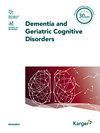Predictors of Awareness of Functional Ability in People with Dementia: The Contribution of Personality, Cognition, and Neuropsychiatric Symptoms – Findings from the IDEAL Program
IF 2.2
4区 医学
Q3 CLINICAL NEUROLOGY
引用次数: 4
Abstract
Introduction: Discrepancy scores reflecting the difference between parallel ratings made by people living with dementia (PwD) in the mild-to-moderate stages and by their informants provide a way to investigate awareness of functional ability in relation to activities of daily living (ADL). Methods: Two measures of ADL (Functional Activities Questionnaire; Dependence Scale) were completed by 1,227 PwD and their informants in the IDEAL cohort study baseline assessment. Self-rated and informant-rated scores were used to calculate discrepancies, which were used as an indicator of awareness of functional ability. Smaller discrepancy scores were considered to reflect greater awareness on the part of PwD. PwD completed questionnaires on depression, personality, comorbidities, neuropsychiatric symptoms, and completed a measure of cognition. Informants provided ratings of stress. Univariable and multiple regressions were used to investigate factors related to ADL discrepancy. Results: A similar pattern of associations were found for both ADL discrepancy scores. Smaller discrepancy scores were associated with higher levels of depression, higher neuroticism, fewer neuropsychiatric symptoms, higher comorbidity, lower carer stress, and receipt of less than 1 hour of care per day from the informant. Discussion/Conclusion: There was a clear pattern of factors that were associated with greater awareness for both measures of functional ability. These factors associated with smaller discrepancy scores could be used to identify PwD who might benefit from targeted interventions to support their independence.痴呆症患者功能能力意识的预测因素:人格、认知和神经精神症状的贡献——IDEAL项目的研究结果
引言:反映轻度至中度痴呆症患者(PwD)和其信息提供者进行的平行评分之间差异的差异评分提供了一种调查与日常生活活动(ADL)相关的功能能力意识的方法。方法:在IDEAL队列研究基线评估中,由1227名PwD及其线人完成ADL(功能活动问卷;依赖量表)的两项测量。使用自我评分和线人评分来计算差异,这些差异被用作功能能力意识的指标。较小的差异分数被认为反映了普华永道的更高意识。PwD完成了关于抑郁症、人格、合并症、神经精神症状的问卷调查,并完成了认知测量。告密者提供了压力等级。采用单变量和多元回归方法研究ADL差异的相关因素。结果:两种ADL差异评分的关联模式相似。差异得分越小,抑郁程度越高,神经质越高,神经精神症状越少,合并症越高,护理人员压力越低,每天接受的护理时间少于1小时。讨论/结论:有一个明确的因素模式与对这两种功能能力指标的更高认识有关。这些与较小差异分数相关的因素可用于确定可能从有针对性的干预措施中受益的普华永道,以支持他们的独立性。
本文章由计算机程序翻译,如有差异,请以英文原文为准。
求助全文
约1分钟内获得全文
求助全文
来源期刊
CiteScore
4.70
自引率
0.00%
发文量
46
审稿时长
2 months
期刊介绍:
As a unique forum devoted exclusively to the study of cognitive dysfunction, ''Dementia and Geriatric Cognitive Disorders'' concentrates on Alzheimer’s and Parkinson’s disease, Huntington’s chorea and other neurodegenerative diseases. The journal draws from diverse related research disciplines such as psychogeriatrics, neuropsychology, clinical neurology, morphology, physiology, genetic molecular biology, pathology, biochemistry, immunology, pharmacology and pharmaceutics. Strong emphasis is placed on the publication of research findings from animal studies which are complemented by clinical and therapeutic experience to give an overall appreciation of the field.

 求助内容:
求助内容: 应助结果提醒方式:
应助结果提醒方式:


